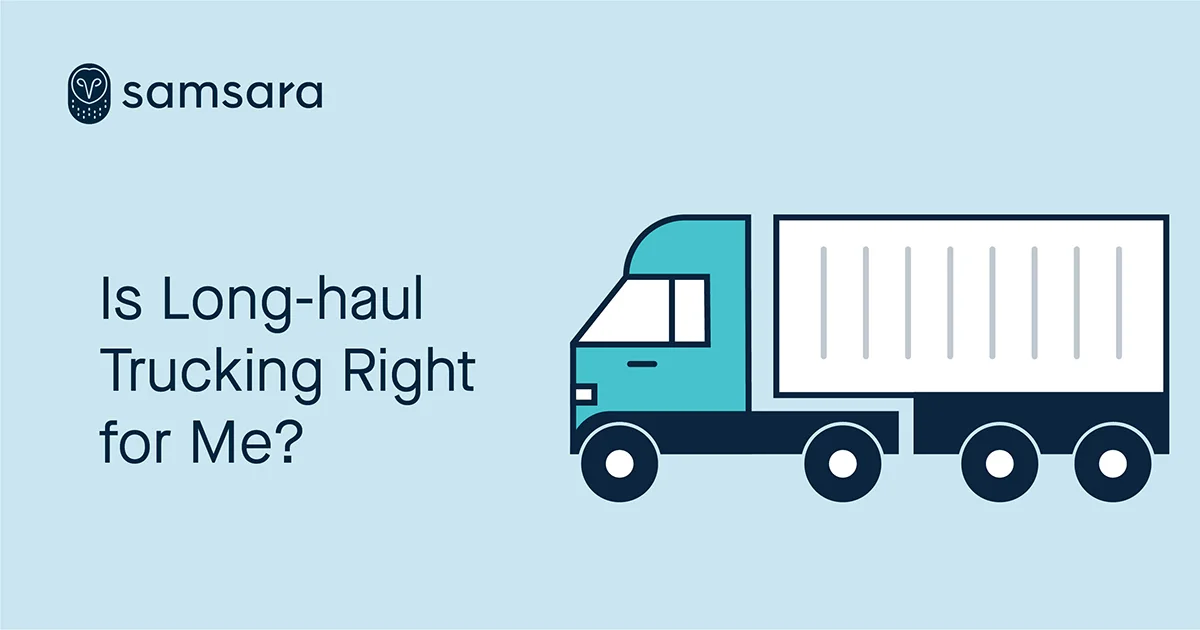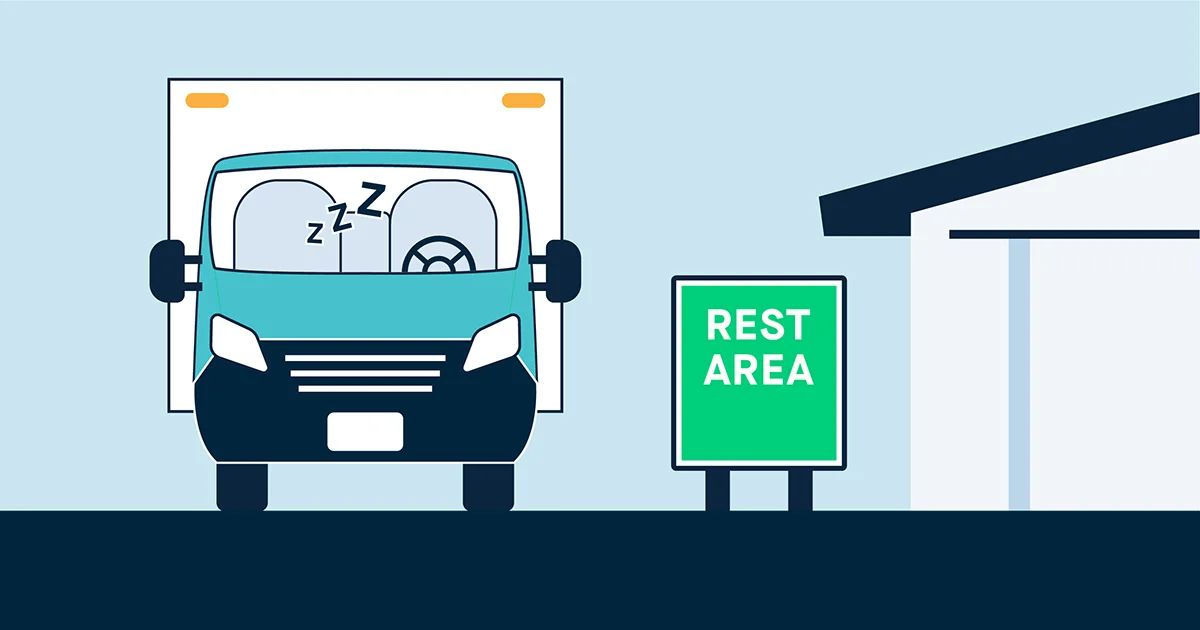Is Long-Haul Trucking Right for Me?
July 31, 2020

Get Started with Samsara
Check our pricesKey Takeaways
Long-haul trucking has many opportunities for career advancement and security due to the high demand of truck drivers. Before deciding whether truck driving is a career you want to pursue, it is important to understand the lifestyle that a trucker lives while on the road, the challenges they face, and what the work entails.
Long-haul trucking is a rewarding job that comes with travel and a lot of autonomy. Many truckers enjoy the power of commanding big-rig vehicles and the abundant freedom of the road.
Many benefits come with long-haul trucking, including a high salary. The average national salary for the trucking industry is $53,000. Some industries and companies offer much more to experienced drivers. Job security for long-haul truckers is high. The Bureau of Labor Statistics suggests that the trucking industry and trucking spend will grow by 5% by 2028.
That’s because long-haul truckers are a huge part of the transportation economy. Truckers move 71% of all the freight in America and are a key part of any supply chain. And there is an increasing demand for more truck drivers.
According to the American Trucking Associations’ (ATA) Driver Shortage Report, there was a shortage of 60,800 truck drivers in 2018, with an expected increase to 160,000 by 2028. The ATA states that the long-haul trucker shortage is due to veteran drivers retiring.
But long-haul trucking, also known as over the road (OTR) trucking, is more than just a job. It is a lifestyle. OTR truckers are on the road for weeks at a time, which is challenging for drivers’ work-life balance.
This article will detail what OTR trucking work entails, how to become an OTR trucker, and how long-haul trucking compares to short-haul trucking. We’ll also highlight key challenges OTR truckers face and ways to overcome them safely.
What is a long-haul truck driver?
An OTR truck driver is someone who drives long distances to deliver goods and cargo. They travel across state lines or even internationally into Canada and Mexico.
Usually, OTR truckers drive over a 250-mile radius, but many find longer distances more rewarding. When surveyed, OTR truckers most enjoyed journeys on rural highways that ran over 1,000 miles. Long-haul truckers enjoy the open road and smooth highway driving.
Most OTR truckers work in fleets, which can be a dedicated third-party trucking company or an internal brand fleet like Walmart’s. This organizational structure helps coordinate shipments and facilitate trucking jobs for drivers. Dedicated dispatchers find loads and distribute them across company drivers so the drivers themselves can focus on the road.
What is an owner-operator?
Another option for OTR drivers is to become owner-operators. As the name suggests, owner-operators own their trucking rig and drive it themselves or in a small team. The benefit of team driving is that drivers can keep the rig active when they want home time. But either way, owner-operators can be their own boss and set their own hours.
Since owner-operators also act as fleet managers, they’re responsible for purchasing their own vehicle insurance, ensuring electronic logging device (ELD) regulation compliance, and coordinating loads themselves. This can make income a lot more variable than in larger fleets with a dedicated dispatch office.
Some large fleets will also partner with owner-operators. Similar to franchising, fleet owner-operators act as free agents under the umbrella of a larger fleet.
Some fleets regularly use owner-operators. The fleet provides the load requests and insurance, and the driver takes home the vast majority of the gross pay per load. This payment plan can vary depending on what drivers transport, but fleets can pay drivers more of the load fee instead of paying them by the hour or mile.
What does a long-haul trucker do?
OTR truckers spend most of their time on the road and carry many responsibilities. They need to stay focused on driving safely while maneuvering and maintaining large vehicles.
Drivers are responsible for the safe loading and unloading of their cargo. OTR Truckers can transport varied loads from one week to the next, with each load having special considerations. For example, different shipments have different loading and transporting concerns, including temperature monitoring or extra safety precautions for delicate loads.
While fleets help to facilitate services, most drivers need to maintain their vehicles. This means ensuring everything from tire pressure, fluid levels, and inspection history are accurate and in good shape. Ensuring that vehicles are maintained, and that drivers are driving safely will help lower fuel costs and improve the rig’s longevity.
To give clients a good impression, truck drivers also clean their trucks. Some companies provide truck washes, but otherwise, truckers coordinate the wash and maintenance.
What is the difference between long-haul and short-haul trucking?
The logical difference between OTR and short-haul trucking is distance. OTR trips are usually over 250 miles and often are much longer, while short-haul trips are often under 150 miles.
But the experiences of driving long and short-hauls go beyond distance. Long-haul drivers usually stick to highways for hours or days, only navigating cities and smaller roads at the beginning and end of a route. Even drivers with many years’ experience find navigating tight turns in a tractor-trailer stressful, so the relative peace of a highway driving experience benefits long-haul trucking.
Short-haul drivers often spend most of their routes on smaller local roads. They may load and unload multiple shipments in a day. If they’re compensated by the mile, that loading time goes unpaid.
The work-life balance between long and short-haul trucking is the biggest difference between the roles. OTR truckers are often on the road for long periods. They eat at truck stops and sleep in their trucks, which are often outfitted with amenities like mini-fridges or Dish TV.
This kind of lifestyle attracts lone-wolf types who enjoy their freedom and autonomy. While OTR drivers make substantially more money than short-haul drivers, some long-haul truckers save additional money on rent by living in their rigs full-time.
Short-haul truckers go home almost every night, can see their families, and eat home-cooked meals. That said, short-haul drivers have hours of service (HOS) exemptions and sometimes spend more long hours on the road, up to 16-hours a day.
What are some challenges facing long-haul truckers?
The gains of OTR trucking come with several challenges, but some solutions help savvy truckers combat them.
1. Fuel costs
Tractor-trailers can consume over 20,000 gallons of diesel fuel a year, so the cost is significant. Annual fuel expenses can easily exceed $50,000.
Trucking companies usually give their drivers designated credit cards to use when purchasing fuel, but fueling costs are one of the biggest expenses for owner-operators. One easy way to save money on fuel is to drive more efficiently. By optimizing route plans and reducing idling time, drivers can save money on fuel and improve their carbon footprint.
Samsara Fuel Reporting automatically monitors fuel consumption and can provide drivers with regular updates on how to drive more efficiently. Also, drivers can get routing recommendations so they can drive as efficiently as possible and arrive to their destination on time.

2. Hours of Service (HOS) compliance
Hours of Service (HOS) regulations and guidelines are in place to help OTR truckers manage their hours so they can reduce fatigue and prevent accidents. HOS rules dictate how many hours truckers can drive at a time and the length of rest periods between journeys. For a complete rundown of the regulations, check out this free guide.
Trucks are required to use electronic logging devices, also known as ELDs, to track vehicle activity like engine performance. This ensures that drivers comply with HOS regulations and rest when they need to.
Samsara offers HOS compliant ELDs that go beyond simple hours of service tracking. Drivers can easily submit reports through the streamlined Samsara Driver App. And since Samsara ELD devices offer built-in WiFi, drivers can use their own cell phones without paying for expensive data plans.
3. Rejected shipments
OTR truckers sometimes face rejected shipments. There can be a host of reasons that clients reject shipments, from improperly loaded or spoiled goods to delayed deliveries. Shipments can be worth thousands of dollars, and it can be devastating to the owner-operators that have to absorb those costs.
Each type of rig and shipment has different loading considerations. Flatbed loads need to be carefully secured since they are exposed to the open air. Drivers may need to put tarps over them if exposure to rain and wind could damage the goods.
On the other hand, refrigerated loads on reefer trucks need careful temperature monitoring throughout the journey to ensure that the goods don’t spoil during transit.
Rejected goods can cost fleets hundreds of thousands of dollars and damage client relationships, so truckers can benefit from Samsara’s real-time temperature monitoring system to alert them to any risks.
How do I become a long-haul trucker?
Consider a rewarding career on the open road as an OTR trucker if you relish the freedom of life on the open road. The first step is to apply to a trucking school. These schools train you on handling big rigs and prepare you to receive your commercial driver’s license (CDL).
ODL truckers require a CDL Class A License. Some companies require drivers to have a high-school diploma, but otherwise, this is the only certification you need to begin long-haul trucking.
You’ll often work with a driving trainer at your first company after CDL training school. You’ll learn from an experienced driver and accompany them on trips. This can be a challenge since drivers are usually more comfortable with solitude, but this training provides valuable real-world experience.
New truck drivers often have to pay their dues for a year or two to gain experience. Company fleets will often assign newer drivers the least attractive and least lucrative loads. Since these drivers haven’t proven trust with more valuable cargo, it’s a way to determine if you have the right focus and care to handle bigger loads.
Your future in long-haul trucking
If you think OTR trucking is right for you, find a training school that appeals to you and apply today. It may take you a little while to get started. But once you drive, you’ll find yourself a part of a dedicated trucker community.
As an OTR trucker, you’ll traverse the continent facilitating supply chains for critical goods and products. It’s rewarding work that you can shape into a lifelong career.
Whether you work as an owner-operator or part of a larger fleet, you’ll learn and grow as an OTR trucker. Samsara offers a suite of telematics solutions specifically for OTR truckers, so we’ll support you every step of the way.